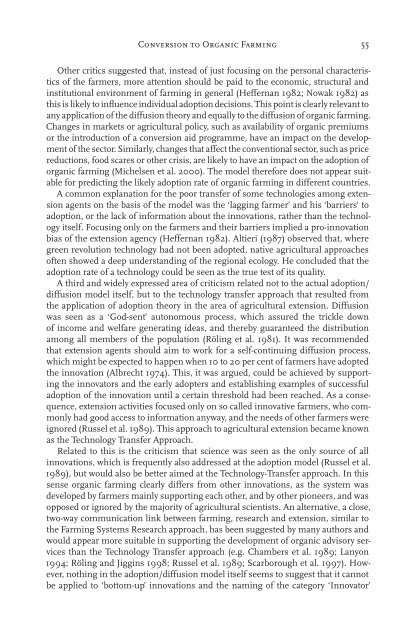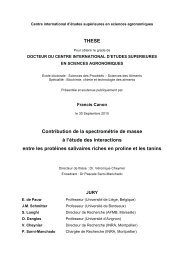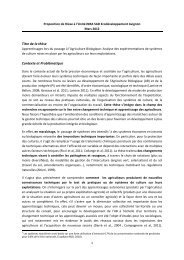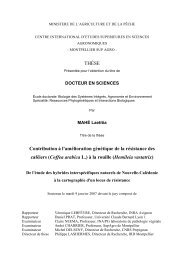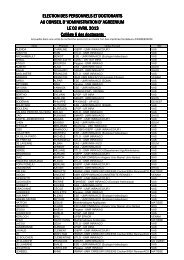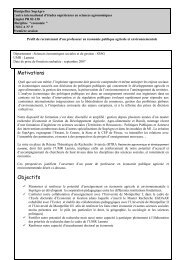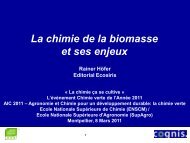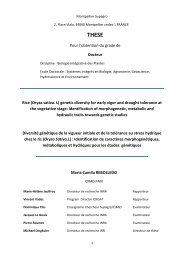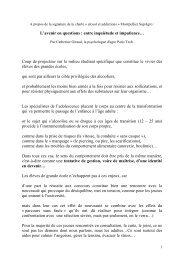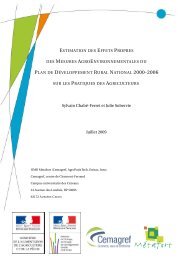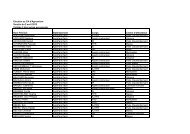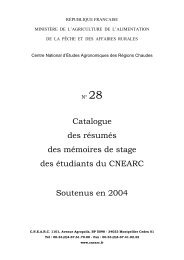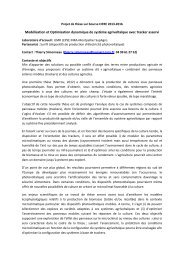Conversion to Organic Farming: A Typical Example of the Diffusion ...
Conversion to Organic Farming: A Typical Example of the Diffusion ...
Conversion to Organic Farming: A Typical Example of the Diffusion ...
Create successful ePaper yourself
Turn your PDF publications into a flip-book with our unique Google optimized e-Paper software.
<strong>Conversion</strong> <strong>to</strong> <strong>Organic</strong> <strong>Farming</strong>55O<strong>the</strong>r critics suggested that, instead <strong>of</strong> just focusing on <strong>the</strong> personal characteristics<strong>of</strong> <strong>the</strong> farmers, more attention should be paid <strong>to</strong> <strong>the</strong> economic, structural andinstitutional environment <strong>of</strong> farming in general (Heffernan 1982; Nowak 1982) asthis is likely <strong>to</strong> influence individual adoption decisions. This point is clearly relevant <strong>to</strong>any application <strong>of</strong> <strong>the</strong> diffusion <strong>the</strong>ory and equally <strong>to</strong> <strong>the</strong> diffusion <strong>of</strong> organic farming.Changes in markets or agricultural policy, such as availability <strong>of</strong> organic premiumsor <strong>the</strong> introduction <strong>of</strong> a conversion aid programme, have an impact on <strong>the</strong> developmen<strong>to</strong>f <strong>the</strong> sec<strong>to</strong>r. Similarly, changes that affect <strong>the</strong> conventional sec<strong>to</strong>r, such as pricereductions, food scares or o<strong>the</strong>r crisis, are likely <strong>to</strong> have an impact on <strong>the</strong> adoption <strong>of</strong>organic farming (Michelsen et al. 2000). The model <strong>the</strong>refore does not appear suitablefor predicting <strong>the</strong> likely adoption rate <strong>of</strong> organic farming in different countries.A common explanation for <strong>the</strong> poor transfer <strong>of</strong> some technologies among extensionagents on <strong>the</strong> basis <strong>of</strong> <strong>the</strong> model was <strong>the</strong> ‘lagging farmer’ and his ‘barriers’ <strong>to</strong>adoption, or <strong>the</strong> lack <strong>of</strong> information about <strong>the</strong> innovations, ra<strong>the</strong>r than <strong>the</strong> technologyitself. Focusing only on <strong>the</strong> farmers and <strong>the</strong>ir barriers implied a pro-innovationbias <strong>of</strong> <strong>the</strong> extension agency (Heffernan 1982). Altieri (1987) observed that, wheregreen revolution technology had not been adopted, native agricultural approaches<strong>of</strong>ten showed a deep understanding <strong>of</strong> <strong>the</strong> regional ecology. He concluded that <strong>the</strong>adoption rate <strong>of</strong> a technology could be seen as <strong>the</strong> true test <strong>of</strong> its quality.A third and widely expressed area <strong>of</strong> criticism related not <strong>to</strong> <strong>the</strong> actual adoption/diffusion model itself, but <strong>to</strong> <strong>the</strong> technology transfer approach that resulted from<strong>the</strong> application <strong>of</strong> adoption <strong>the</strong>ory in <strong>the</strong> area <strong>of</strong> agricultural extension. <strong>Diffusion</strong>was seen as a ‘God-sent’ au<strong>to</strong>nomous process, which assured <strong>the</strong> trickle down<strong>of</strong> income and welfare generating ideas, and <strong>the</strong>reby guaranteed <strong>the</strong> distributionamong all members <strong>of</strong> <strong>the</strong> population (Röling et al. 1981). It was recommendedthat extension agents should aim <strong>to</strong> work for a self-continuing diffusion process,which might be expected <strong>to</strong> happen when 10 <strong>to</strong> 20 per cent <strong>of</strong> farmers have adopted<strong>the</strong> innovation (Albrecht 1974). This, it was argued, could be achieved by supporting<strong>the</strong> innova<strong>to</strong>rs and <strong>the</strong> early adopters and establishing examples <strong>of</strong> successfuladoption <strong>of</strong> <strong>the</strong> innovation until a certain threshold had been reached. As a consequence,extension activities focused only on so called innovative farmers, who commonlyhad good access <strong>to</strong> information anyway, and <strong>the</strong> needs <strong>of</strong> o<strong>the</strong>r farmers wereignored (Russel et al. 1989). This approach <strong>to</strong> agricultural extension became knownas <strong>the</strong> Technology Transfer Approach.Related <strong>to</strong> this is <strong>the</strong> criticism that science was seen as <strong>the</strong> only source <strong>of</strong> allinnovations, which is frequently also addressed at <strong>the</strong> adoption model (Russel et al.1989), but would also be better aimed at <strong>the</strong> Technology-Transfer approach. In thissense organic farming clearly differs from o<strong>the</strong>r innovations, as <strong>the</strong> system wasdeveloped by farmers mainly supporting each o<strong>the</strong>r, and by o<strong>the</strong>r pioneers, and wasopposed or ignored by <strong>the</strong> majority <strong>of</strong> agricultural scientists. An alternative, a close,two-way communication link between farming, research and extension, similar <strong>to</strong><strong>the</strong> <strong>Farming</strong> Systems Research approach, has been suggested by many authors andwould appear more suitable in supporting <strong>the</strong> development <strong>of</strong> organic advisory servicesthan <strong>the</strong> Technology Transfer approach (e.g. Chambers et al. 1989; Lanyon1994; Röling and Jiggins 1998; Russel et al. 1989; Scarborough et al. 1997). However,nothing in <strong>the</strong> adoption/diffusion model itself seems <strong>to</strong> suggest that it cannotbe applied <strong>to</strong> ‘bot<strong>to</strong>m-up’ innovations and <strong>the</strong> naming <strong>of</strong> <strong>the</strong> category ‘Innova<strong>to</strong>r’


